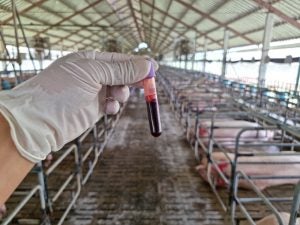Amid African swine fever, inflation, and policy challenges, the global pig market remains strong, according to the Global Animal Protein Sector’s quarterly pork report. At the top of the pork chain is North America, while demand improves in the European Union with tighter supplies and fluctuation in Asian country supply and demand due to pandemic shutdowns and African swine fever outbreaks.
Despite these challenges, pork remains a top seller in many markets as a middle-cost protein. Producers are experiencing decreased pressures as feed and energy costs soften slightly. However, the overall trade flow of the global pork market has eased.

North American markets remain strong, and ASF free despite decreased exports
Thankfully, North American producers maintain a robust and profitable margin with a stable demand – however, economic challenges may weaken future American markets. Meanwhile, African swine fever is being kept at bay while remaining a solid concern for producers. An accelerated movement in education and prevention efforts limits the risk of introduction into local herds.
Amidst differentiating markets, U.S. exports decreased a complete 20 percent, with sharp declines in sales to China, offset only by a more substantial export market to Mexico. U.S. sow herds decreased by about 0.8 percent. Increased costs, harvesting capacity, and regulation seem to have kept expansion on hold, while a continuously strong market may eventually lead to growth.
Asian market is challenged by COVID-19, low herd numbers, and ASF
China’s pork market, however, remains a place of speculation. Rising inflation concerns and the nation’s COVID crisis make for a more uncertain market. Surging hog prices due a tight supply and high demands have pushed policies to stabilize prices and control inflation. Japan’s high pork prices are slowing pork consumption, while imports remain strong. In Southeast Asia, pork prices have been rising in Vietnam due to tight supplies.
African swine fever continues to impact local production and prices in Asia, especially in Vietnam and the Philippines. Meanwhile, culling and herd liquidations have driven Thailand’s pork supply up by 60 percent, while herd numbers could drop by as much as 35 percent over the year. Vietnam and the
Pork demands in China and Japan remain lower, while the country’s hog prices have increased while entering July 2022. Pork consumption’s decreases across the country are attributed to widespread lockdowns and an increase in pork prices in 2022. Demand is expected to recover with a tighter supply raising hog prices further into the year. While Chinese pork demands have been low, Japan has increased its imports while shifting away from higher-priced beef options.

European Pork markets see rising pork costs with decreased herd sizes
Pig prices in Europe are supported and growing due to a tighter supply and summer demands. To diversify their pork market, exports to other countries are being explored due to low volumes exported to China, while European countries struggle with declining swine numbers.
African swine fever continues to challenge European facilities. The latest cases of ASF have spread across Eastern Europe, including Germany, Poland, Italy, and westward. ASF outbreaks are being attributed to human activity and wild boar movement.


